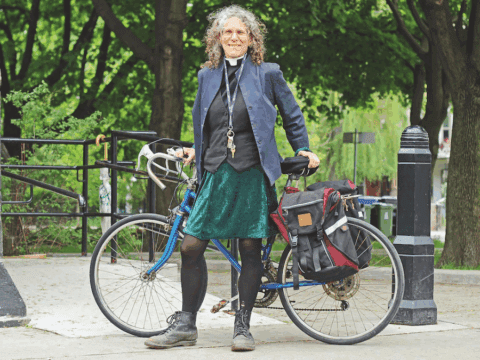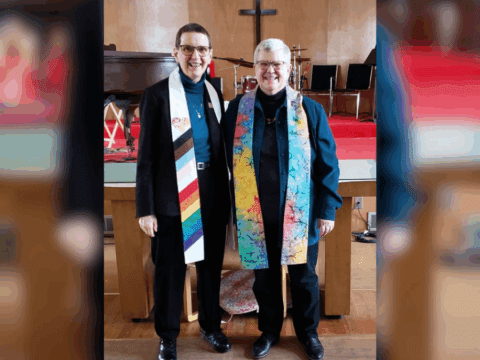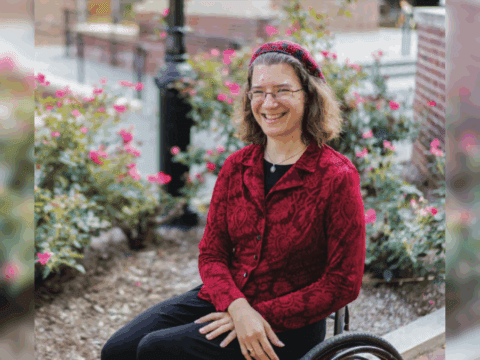A certain corner of my garden makes me think of Kimberley Robinson, who is one of the pillars holding up the congregation I attend. She gave me the sweetgrass flourishing here, filling the air with its scent. Robinson is Algonquin — her grandmother was from the Golden Lake First Nation — and a member of St. Andrew’s United in North Bay, Ont., where she sings in the choir and volunteers generously. She is also part of a Native women’s drumming group that meets by Lake Nipissing in summer and in the church parlour in winter. She honours both traditions, holding them gracefully together in her own person.
I wish this holding-together for our whole United Church. I wish that we could pick up the pieces of Native spirituality shattered by Christianity centuries ago, unhook our faith from our culture and offer it as a gift and receive gifts in return. I don’t think I am alone. It’s a yearning named in 1986, when this church apologized to Native congregations for not hearing “when you shared your vision.”
How can the spiritualities of Native and non-Native people co-exist in one church, though, when our ways of being are so deeply different, when one cherishes sweetgrass and tobacco and the other bread and wine?
They can, says Robinson. But it requires being very open. When she set out to honour her grandmother’s Native heritage and her own, she “made an intention, that I would open myself to learning the teachings as they were offered.” Not long afterward, at a Manitou Conference women’s event, two Ojibwa women offered a workshop. “They said, `We’re going to invite the grandmothers into the room,'” and soon Robinson had picked up a drum and found her voice. “This feels right,” she thought. “This has to be the best thing that’s happened to me in a long time.”
The teachings cascaded from there. She arrived at church one morning covered with blackfly bites, contented and tired from a moon ceremony the night before, with sacred fire and tobacco, a circle of women in the trees. Last Sunday she offered the prayers of the people, as she often does. “May we take care of the water,” she said in part. “Water cleanses us. It is sacred and nourishing. Humbly we ask for wisdom and understanding. Megwetch. Amen.” Robinson always feels connected to the earth when she prays, she says, and “the drumming and the women’s circle, it fits with these prayers.”
You don’t have to be Native to be open to that spirituality. Many of the women in Robinson’s drumming circle are non-Native. That’s also the experience of Ruth McQuirter Scott, a member of Port Nelson United in Burlington, Ont. She’s been studying with a Métis shaman for many years. When she began, she found it required a “willingness to be challenged, to see spirituality in a much broader sense than I had previously learned though Christianity.” At first she was shocked by “the immediacy, the sense of the cosmos” that was filled with “angels, or spirit guides, surrounding you.”
McQuirter Scott had learned about angels in Sunday school, certainly, but they were “far removed beings with wings, that didn’t connect with me.”
But she soon discovered that the more she learned of Native spirituality, the more meaningful her own Christianity became.
“I learned,” she says slowly, “that we have underestimated Jesus.”
While his miracles are sometimes labelled “metaphor” by conventional Christianity, she is now more inclined to see Jesus “as one of the ultimate shamans.” And when it comes to a miracle, “shamans could do this. It could have really happened.”
Like Robinson, McQuirter Scott emphasizes the importance of listening carefully for “each unique opportunity to learn.” Her studies have instilled in her a strong sense that we have “a personal responsibility to live a life that is meaningful.” That means there is no one moment of “being saved, I’ve got it.” She sees in Native teachings “a school for spirituality. Life is a process, you always look at `What has this lesson been put in place to teach me?’ It is more respectful. You don’t look at life as having arrived. You are just at a different point on the path.”
We are more able to be open to each other if we know each other well. Métis traditional elder Jules Lavallee from Gateway, Man., is a strong supporter of the Dr. Jesse Saulteaux Resource Centre in Beausejour, Man. “Dr. Jesse Saulteaux wanted to encourage people to honour both the traditional ways of Aboriginal people and Christian teachings,” he says. “That was her vision.”
Lavallee is clearly sympathetic. “Absolutely, it can be done,” he says, but “you need to know the protocol.” Just as it takes a while to become a minister, it takes “quite a while for people to acquire the right to do the ceremonies,” and it’s better if “you feel comfortable with that individual and know you are going to be honoured and appreciated.”
But he is also clear that this is never a matter of blending the two traditions. “That wouldn’t work.” We have to understand “there is a difference. But the more we understand each other’s way, the more we realize there are many similarities.”
Kimberley Robinson agrees and points to some things that are the same. The sense of belonging and security that clings to both church and the drumming group, each “a safe place to fall.” The infusion of energy from drumming that sustains her “until the following circle. It is like Wednesday worship (at church); you get an energy that carries you for the rest of the week.” Christians steeped in Celtic worship find especially familiar the Native understanding of prayer as part of daily life.
Knowing each other well means we don’t ignore either spirituality. Moderator Rt. Rev. David Giuliano, whose Marathon, Ont., congregation is near the Pic River Reserve, remembers an elder at a sweat lodge and healing circle to which Giuliano was invited: “When non-Native people come to learn,” the elder said, “I want to ask `What are you bringing to the circle?'”
“What can I contribute,” Giuliano recalls thinking at the time, “if I don’t bring my own tradition as well?” What is required is offering that tradition “with humility. The mystery is much bigger than we can enact symbolically; two conflicting things can be true. That kind of humility makes the conversation possible,” Giuliano says. Then, well-acquainted, we are able “to trust that we want good for each other,” and we can be “citizens of a place we imagine together.”
Getting to that place is a matter of mutual hospitality. “People have to be willing to open their space — not just their building — to allow other people to nurture their spirits, however that will happen,” says Robinson.
Last Sunday, at lunch after church, Robinson was holding Vijanti and Dana Murphy’s baby, singing a grandmother’s lullaby to him that she had learned at her women’s drumming circle. “Humma, humma, humma, hya,” she sang. “Hi yo way hi yo.” The baby was manifestly content.
I listened and thought about the sweetgrass Robinson had given me, spreading freely in my garden. I have not learned the rituals of picking it, the braiding and smudging, so I don’t attempt them. It would not be respectful.
But when I inhale its scent, I understand that the land is holy and full of spirits. I cannot pretend another spirituality is my own. But — as a citizen of this church — I can honour and befriend all the spiritualities within it, and let them teach me what I need to know.
This story originally appeared in the November 2006 issue of The Observer with the title “Native spirituality and Christian faith.”















